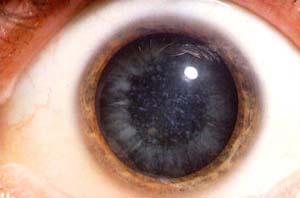|
|
 |
External Eye Photography
Lighting
William C. Nyberg, RBP CRA
Scheie Eye Institute
University of Pennsylvania

Cataract Through Dilated Pupil
Electronic flash is so practical that consideration of other sources, such as incandescent, for routine photography will not be considered here.
As with all photography, the actual rendition of the subject matter is done with light. Good lighting is crucial to the success of external photography. External eye photos are specialized medical photographs, and they are usually best made with a single, carefully placed light source, coming from superior to the patient anatomy. Single light sources typically yield pictures that are less confusing to view than those from multiple sources. Additional light sources should be used with extreme caution. A "white card fill" is useful when additional lighting is needed to lower the lighting ratio by filling in a shadow. It is much safer to use than an additional light, but is only rarely needed in ophthalmic external photography.
"Straight ahead" medical/ophthalmic face pictures are best done with the single light directly above the lens as this provides equal light to each side of the face. Lighting to reveal morphology is best accomplished with conventional methods. "45 degree, 45 degree" so called "architectural lighting" is a good place to begin. The light source is placed 45 degrees above and 45 degrees away from the front of the subject, and then adjusted to suit the individual situation.
Most external photographers use some system to mount the light source on the camera or on the lens. The lens option more frequently allows the light to be rotated around the lens axis. Whether mounted on lens or camera, flexibility in light placement is desirable. This allows individual lesions to be revealed to best advantage.
It is also desirable to have a light source that incorporates a modelling light. A modelling light is a continuously burning incandescent light that is designed to work in concert with the electronic flash tube so as to show the effect of the flash in the final image. Modelling lights allow the photographer to see exactly where highlights, specular reflections, and shadows will appear. All is not lost, however, if the photographer does not have the luxury of a modelling light. In fact, most of the commonly available, small, light weight, electronic flash sources do not have this feature. Excellent photographs can be made by experienced people using their knowledge and skill to place the light in its most advantageous position. A small flash light can be used to practice and visualize different lighting effects.
|
 |
|